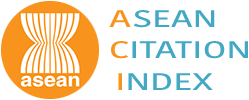ไฮโดรเจลไคโตซาน/พอลิ(ไฮดรอกซีเอทิล เมทาไครเลต) : การเตรียม สมบัติ และการใช้เป็นวัสดุดูดซับสีย้อมในน้ำทิ้ง
คำสำคัญ:
ไฮโดรเจล, ไคโตซาน, พอลิ(ไฮดรอกซีเอทิล เมทาไครเลต) , วัสดุดูดซับ, การกำจัดสีย้อมบทคัดย่อ
วัตถุประสงค์และที่มา : งานวิจัยนี้ต้องการพัฒนาไฮโดรเจลพอลิเมอร์สำหรับใช้เป็นวัสดุดูดซับเพื่อกำจัดสีย้อมจากแหล่งน้ำ เนื่องจากสีย้อมถูกใช้ในปริมาณมากสำหรับอุตสาหกรรมการผลิตหลายประเภท เป็นสารมลพิษที่มักพบในแหล่งน้ำธรรมชาติ โครงสร้างโมเลกุลมีความเสถียร สลายตัวได้ยากในสิ่งแวดล้อม ดังนั้นสีย้อมปริมาณเพียงเล็กน้อยที่ปนเปื้อนในแหล่งน้ำ ก็สามารถส่งผลกระทบต่อสิ่งแวดล้อมได้ในระยะยาว
วิธีดำเนินการวิจัย : ไฮโดรเจลพอลิเมอร์ผสมระหว่างไคโตซาน (CS) และพอลิไฮดรอกซีเอทิล เมทาไครเลต (PHEMA) ถูกเตรียมจากพอลิเมอไรเซชันแบบแรดิคัลของไฮดรอกซีเอทิล เมทาไครเลตมอนอเมอร์ ในสภาวะของปฏิกิริยาซึ่งมีองค์ประกอบของไคโตซานที่เกิดการเชื่อมโยงระหว่างโมเลกุลด้วยเจนิพิน จากนั้นนำสารผสมของปฏิกิริยาไปขึ้นรูปเป็นเม็ดไฮโดรเจลทรงกลม แล้วนำไปดัดแปรทางเคมีด้วยปฏิกิริยาไฮโดรไลซิสให้มีหมู่ฟังก์ชันสำหรับใช้เป็นวัสดุดูดซับสีย้อมในน้ำทิ้ง
ผลการวิจัย : จากการวิเคราะห์ไฮโดรเจลที่พัฒนาขึ้นด้วยเทคนิค FTIR, SEM, ทดสอบการบวมในน้ำ ศึกษาประสิทธิภาพการดูดซับโดยใช้เมทิลีนบลูเป็นสีย้อมต้นแบบ รวมทั้งศึกษาปัจจัยที่มีผลต่อการดูดซับ พบว่า CS/PHEMA ไฮโดรเจลมีประสิทธิภาพในการกำจัดเมทิลีนบลูสูงสุดเท่ากับ 327 มิลลิกรัม/กรัม และสามารถดูดซับเมทิลีนบูลในสารละลายเข้มข้น 50 มิลลิกรัมต่อลิตรได้ถึง 99.5% ไอโซเทอร์มของการดูดซับสอดคล้องกับแบบจำลองของแลงเมียร์ เมื่อใช้ดูดซับแล้วสามารถชะสีย้อมออกจากเม็ดไฮโดรเจล แล้วนำกลับไปใช้ซ้ำได้โดยที่ประสิทธิภาพยังคงเดิม
สรุปผลการวิจัย : CS/PHEMA ไฮโดรเจลที่พัฒนาขึ้นในงานวิจัยนี้มีศักยภาพในการใช้เป็นดูดซับสีย้อมในน้ำทิ้ง และสามารถใช้ดูดซับซ้ำหลายครั้งได้เพื่อลดต้นทุนในการบำบัดน้ำได้
เอกสารอ้างอิง
Al-Gheethi, A. A., Azhar, Q. M., Kumar, P. S., Yusuf, A. A., Al-Buriahi, A. K., Mohamed, R. M. S. R., & Al-Shaibani, M. M. (2022). Sustainable approaches for removing Rhodamine B dye using agricultural waste adsorbents: A review. Chemosphere, 287, 132080.
Ayon, M. A. G., Hoppenstedt, A. M., López, A. Z., Sarabia, J. B., Claverie, A. L., & Urías, M. A. G. (2024) Semi‐interpenetrated polymer networks based on PHEMA and modified chitosan as a potential bactericide hydrogel for wound‐healing. Macromolecular Chemistry and Physics, 2400018.
Duman, O., Polat, T. G., Diker, C. O., & Tunc, S. (2020). Agar/-carrageenan composite hydrogel adsorbent for the removal of Methylene Blue from water. International journal of biological macromolecules, 160, 823-835.
Gajera, R., Patel, R. V., Yadav, A., & Labhasetwar, P. K. (2022). Adsorption of cationic and anionic dyes on photocatalytic flyash/TiO2 modified chitosan biopolymer composite. Journal of Water Process Engineering, 49, 102993.
Kasbaji, M., Mennani, M., Grimi, N., Oubenali, M., Mbarki, M., Zakhem, H. E., & Moubarik, A. (2023). Adsorption of cationic and anionic dyes onto coffee grounds cellulose/sodium alginate double-network hydrogel beads: Isotherm analysis and recyclability performance. International journal of biological macromolecules, 239, 124288.
Katheresan, V., Kansedo, J., & Lau, S. Y. (2018). Efficiency of various recent wastewater dye removal methods: A review. Journal of environmental chemical engineering, 6(4), 4676-4697.
Kubra, K. T., Salman, M. S., & Hasan, M. N. (2021). Enhanced toxic dye removal from wastewater using biodegradable polymeric natural adsorbent. Journal of Molecular Liquids, 328, 115468.
Lapwanit, S., Sooksimuang, T., & Trakulsujaritchok, T. (2018). Adsorptive removal of cationic methylene blue dye by kappa-carrageenan/poly(glycidyl methacrylate) hydrogel beads: preparation and characterization. Journal of environmental chemical engineering, 6(5), 6221-6230.
Panchal, R., Mateti, T., Likhith, K., Rodrigues, F. C., & Thakur, G. (2022). Genipin cross-linked chitosan–PVA composite films: An investigation on the impact of cross-linking on accelerating wound healing. Reactive and Functional Polymers, 178, 105339.
Rahmatpour, A., Soleimani, P., & Mirkani, A. (2022). Eco-friendly poly (vinyl alcohol)/partially hydrolyzed polyacrylamide/graphene oxide semi-IPN nanocomposite hydrogel as a reusable and efficient adsorbent of cationic dye methylene blue from water. Reactive and Functional Polymers, 175, 105290.
Salunkhe, B., & Schuman, T. P. (2021). Super-adsorbent hydrogels for removal of methylene blue from aqueous solution: dye adsorption isotherms, kinetics, and thermodynamic properties. Macromolecules, 1(4), 256-275.
Sarkhel, R., Ganguly, P., Das, P., Bhowal, A., & Sengupta, S. (2023). Synthesis of biodegradable PVA/cellulose polymer composites and their application in dye removal. Environmental Quality Management, 32(3), 313-323.
Tasdelen, B. (2023). Synthesis, swelling, diffusion and cationic dye adsorption studies of semi‐IPN sodium alginate/poly (HEMA‐co‐MA) hydrogels. Chemistry Select, 8(24), e202300707.
Thanardna, B., Tamura, H., & Furuike, T. (2022). Preparation, Characterization, and properties of chitosan‐based semi-interpenetrating polymer networks and poly(2-hydroxyethyl methacrylate) structure. Macromolecular Chemistry and Physics, 223(24), 2200282.
ดาวน์โหลด
เผยแพร่แล้ว
รูปแบบการอ้างอิง
ฉบับ
ประเภทบทความ
สัญญาอนุญาต
ลิขสิทธิ์ (c) 2024 คณะวิทยาศาสตร์ มหาวิทยาลัยบูรพา

อนุญาตภายใต้เงื่อนไข Creative Commons Attribution-NonCommercial-NoDerivatives 4.0 International License.
Burapha Science Journal is licensed under a Creative Commons Attribution-NonCommercial-NoDerivatives 4.0 International (CC BY-NC-ND 4.0) licence, unless otherwise stated. Please read our Policies page for more information




